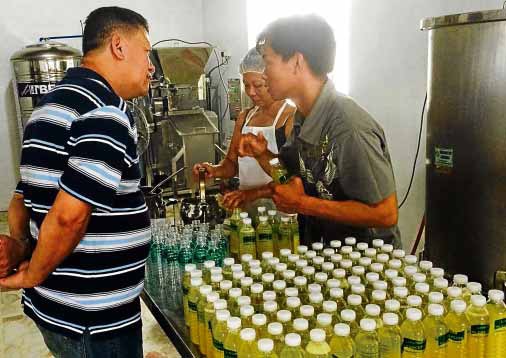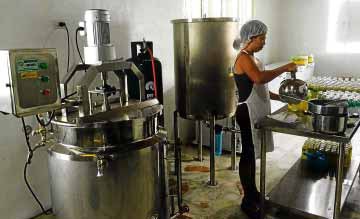Village rice farms shift to calamansi

VICTOR Santos, manager of Concepcion Calamansi Growers and Rice Producers Cooperative in Concepcion, Tarlac, supervises the bottling of natural ‘calamasi’ juice in the cooperative’s production facility.
Text and photos by Gabriel Cardinoza, Inquirer Northern Luzon
CONCEPCION, Tarlac—Rice farmers of an agricultural village here have shifted to planting calamansi to beat the changing weather pattern.
Article continues after this advertisementNemencio Calara, chair of the Concepcion Calamansi Growers and Rice Producers Cooperative (CCGRPC), said the erratic rainfall in the last decade had made it difficult for farmers to plant rice twice a year.
“It’s no longer like before, when you can have two cropping seasons, because there was enough irrigation water,” he said.
Rice farming usually begins at the onset of the rainy season between May and June, while the second cropping season starts in December in irrigated areas.
Article continues after this advertisement“We had to adapt to the climate that we have now. We looked for a plant that did not need so much water but could bring us profit. So we thought of calamansi,” he said.
But the decision to shift to calamansi did not come fast and easy.
Calara first visited calamansi farms in neighboring Nueva Ecija province. Farmers there assured him calamansi was a good investment.

The farmers did not have to plant every year because calamansi, once planted, lasts up to 15 years. It takes three years before it bears marketable-size fruits.
“After harvest, it keeps producing. It is the only plant that assures us that in the next season, there will be bigger harvest because the plant keeps on growing,” Calara said.
Calamansi is also not a seasonal crop, he said. It bears fruit all year round and technology has been developed to generate off-season harvests.
“You can also plant lemon grass, eggplants, pepper in between the trees. So, you can have inter-cropping,” he said.
Convinced it would give them financial windfall, Calara and a small group of farmers in Barangay Talimundoc San Miguel began planting calamansi in their farms three years ago. On Sept. 11, 2013, he organized the CCGRPC, with 34 farmers as initial members.
Today, they are reaping the fruits of their labor.
A half hectare of calamansi farm with 400 calamansi trees yields about 30 sacks of calamansi fruits. Each sack is sold for P1,000 to the cooperative.
Buying the cooperative members’ produce in a way protects them from sudden drop in prices in the market when there is a calamansi glut, Calara said.
“That’s why we are not worried now. If we can’t sell our calamansi fruit at a good price, we can always process it into bottled juice,” he said.
On Dec. 9 last year, the cooperative acquired its calamansi processing facility through a grant from the Department of Trade and Industry.
The facility came after its members went through a product development training conducted by the Department of Science and Technology (DOST) and Pampanga State Agricultural University two months earlier.
The calamansi juice plant is housed in a rented building in Barangay Talimundoc San Miguel, and is now producing 300 250-milliliter bottles of natural calamansi juice daily, said Victor Santos, CCGRPC manager.
Each bottle is sold at a wholesale price of P10 under the trademark “Limunada de Concepcion.”
“At the moment, we sell these to schools in Concepcion, especially now that cola drinks are no longer allowed to be sold in school canteens. This is the right time to sell our product, which is a healthy food, to children,” Santos said.
So far, he said, it is only the cooperative that is engaged in calamansi juice production business in Tarlac. “If we become bigger, we will penetrate the market in Tarlac City,” he said.
He said the facility’s limitation so far was that it did not have a machine to fill the plastic bottles. “We are just starting. Soon, we will be able to acquire the machines we need,” he said.